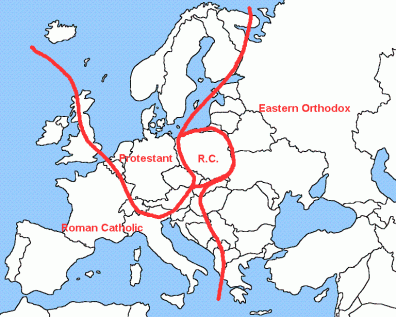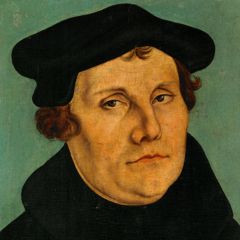Catholics and Protestants
The population of Germany in 1933 was around 60 million. Almost all Germans were Christian, belonging either to the Roman Catholic (20 million members) or the Protestant (40 million members) churches. The Jewish community in Germany in 1933 was less than 1% of the total population of the country(1). Christianity is the largest religion in Germany. Many of the things that are important to Germans and that have shaped their culture have their origin in Christian thinking. (This, in turn, is shaped by a Jewish worldview, which is why Germans sometimes speak about their Judeo-Christian heritage).
In today’s time, about 60% to 70% of the populations are the followers of the Christianity religion in Germany. They are more or less evenly split between the mainstream denominations of Lutheran-Protestantism and Calvinism united in the EKD (Evangelical Church in Germany) and the Roman Catholic Church. Due to the historical development of religion in Germany, these denominations are concentrated in specific regions(2). In the course of the Protestant Reformation and the ensuing Thirty Years’ War in the 15th and 16th centuries, religion in Germany ended up being distributed according to the preferences of local rulers: Therefore, most areas in the South or West (especially Bavaria and Northerner-Westphalia) are Catholic while the North and East are mainly Protestant. However, the Communist regime of the former DDR (German Democratic Republic) frowned upon religion in Germany’s eastern parts until the reunification in 1990. This explains why the percentage of self-confessed atheists is particularly high in these federal states.
religion in Germany. They are more or less evenly split between the mainstream denominations of Lutheran-Protestantism and Calvinism united in the EKD (Evangelical Church in Germany) and the Roman Catholic Church. Due to the historical development of religion in Germany, these denominations are concentrated in specific regions(2). In the course of the Protestant Reformation and the ensuing Thirty Years’ War in the 15th and 16th centuries, religion in Germany ended up being distributed according to the preferences of local rulers: Therefore, most areas in the South or West (especially Bavaria and Northerner-Westphalia) are Catholic while the North and East are mainly Protestant. However, the Communist regime of the former DDR (German Democratic Republic) frowned upon religion in Germany’s eastern parts until the reunification in 1990. This explains why the percentage of self-confessed atheists is particularly high in these federal states.
Other strands of Christian religion in Germany are the so-called Free Evangelical Churches, a loose union of congregations adhering to Baptism, Methodism and related faiths such as the Mennonites, as well as the two Orthodox churches. Christian evangelism in Germany goes back to U.S. American missionary efforts in the 19th century. Both the Greek-Orthodox and the Russian-Orthodox religion in Germany became established here with the Greek and Serbian immigrant population in the 1960s and 1970s(2).
In summary, the Roman Catholicism slowly started to change its shape and reformation began. With the help of Marin Luther the new reformation of Protestantism was born. Later on Protestantism rose to be the major religion of Germany with almost two thirds of the population practicing this faith. The Thirty Year’s War, which was fought on religious grounds, culminated in the division of Germany into regions based on religion. Catholicism prevailed in the southern and western areas. The East German regions and some northern states were predominantly staunch Protestants(3).
Reformation of Protestant
It all started with the man named Martin Luther, who stood against the dominance of Roman Catholic religion. The 16th-century Protestant Reformation, launched by the German Augustinian monk Martin Luther, divided the territories of what is now Germany into a predominantly Protestant North and a predominantly Catholic South. This division endures today. (States that belonged to East Germany were predominantly Protestant, but they saw a substantial decline in religious adherence during communist rule)(4).

Martin Luther
The Protestant reformation divides Christianity into not only two but several denominations including Lutherans, Apostolic Lutherans, Reformed Lutherans, Free Lutherans and Lutherans going back to become Catholics because of the vagueness of the divisions. The Catholic Church made the people believe that, Christians were saved only through faith and the grace of god. Serving the church and paying for the rituals it preformed can help a man clear his door ways to heaven. Martin Luther strongly stood against Church’s belief saying “these rituals didn’t have the power to save a man’s soul” and voiced against Church and the Pope that they make mistakes all the time like common peoples do. Then he went on raising his voice against Church and Officers of the Church, protesting that they have on spiritual powers and people do not need priests to have the grace of God. The most revolutionary step of Luther was his translation of Bible to German Language. With this, people could read the bible, who where literate and created war between liberal thinkers and religious extremist.
There are nearly 29 million Protestants in Germany today, accounting for about a third of the overall population, and most are members of the Evangelical Church in Germany (Evangelische Kirche in Deutschland). Roman Catholics account for a third of the German population, totaling about 28 million. Germany also is home to more than a million Orthodox Christians and more than 500,000 other Christians. According to historical estimates, roughly 60% of Germans were Protestant before World War II, and about one-third professed Roman Catholicism. This suggests that the Protestant proportion of the population has declined significantly, whereas the Catholic proportion has remained roughly the same(4).
The video below explains the reformation process in detail.
However, long stint of Communism has had its effect resulting in a generally atheistic attitude where religion is concerned. In Saxony-Anhalt, the birth place of Martin Luther, only about 19% of the population hold some kind of religious beliefs.The Jewish population was exterminated to a large degree by the world war genocide. In spite of that Germany now has about 100,000 Jews, making it a growing German religion. There are about 3 million Muslims from various countries, notably Turkey, living in Germany. A rising Hindu population has made its presence felt in most major cities of Germany. Europe’s second largest Hindu temple is to be found in(3).
Reference
- Holocaust Encyclopedia, July 2, 2016 “THE GERMANY CHURCHES AND THE NAZI STATE” Available at https://www.ushmm.org/wlc/en/article.php?ModuleId=10005206 (accessed on 10/14/2016)
- InterNation.world wide, 2016 “Religion in Germany” Available at https://www.internations.org/germany-expats/guide/16030-culture-shopping-recreation/religion-in-germany-16010 (accessed on 10/14/2016)
- MyGermanCity.com, 2007 “German Religion is Mainly Christianity” Available at http://www.mygermancity.com/german-religion (Accessed on 10/14/2016)
- Pew Research Center, Dec 19, 2011 “Regional Distribution of Christians” Available at http://www.pewforum.org/2011/12/19/global-christianity-regions/ (accessed on 10/14/2016)

It’s interesting to know that 60-70% of the German population are Christian (reportedly) because I was under the impression that there were more people who didn’t identify with any religion (or are atheist). In Croatia (my blog country), they also discouraged religion while they were under communist rule. I think one of the most obvious cases of the globalization of religion in Germany is through the establishment of the orthodox churches due to the Serbian and Greek immigrants! It’s a very cool thing to see.
LikeLike
Definitely Martin Luther played an importante role in the formation of religious identitity in Germany and although Germany has gone through several conflicts for years, it keeps its religiosity and beliefs.
LikeLike
I find the video really informative and interesting about the history of religion and the journey of Martin Luther from quitting from Law school to ending up to University of Wittenberg where he learnt about salvation and it comes only through faith and his role in the religious identification to the country.
LikeLiked by 1 person
very informative blog .the video provide various information which is really important to know the Martin Luther and his contribution . Overally , very nice blog
LikeLike
Yes, Germany is the birthplace of protestantism, now the fastest growing version of Christianity globally (especially in Africa), but the impact of both communism in Eastern Germany, and rising secular post-enlightenment thinking in Western Germany calls into questions the future of Christianity in Germany.
LikeLike